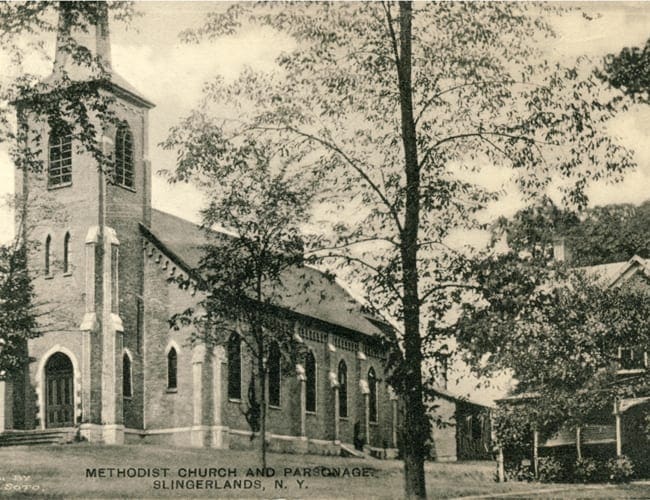The Community United Methodist Church in Slingerlands may soon see new life as a medical office. The project was recently approved by the town’s Zoning Board of Appeals and will now head to the Planning Board. Dr. Peter Forman of Delmar Family Practice is looking to purchase the entire property, with the church renovated into his new offices. “The sense is this is the best use for the church, it would preserve the church and it would effectively be an adaptive reuse as a doctor’s office,” said Chairman Dan Coffey. The proposal unanimously passed the town’s Zoning Board of Appeals on Wednesday, Jan. 21. The area is zoned as a Core Residential district, where apartments and medical offices are not permitted, so a use-variance was needed. The church was forced to close last summer after facing several years of low membership and financial difficulties. The original goal was to find another congregation who may be interested in the site, but after several months of little interest, sale of the property was opened up to the general public. The proposed project would see the 200-year-old church turned into a medical office and four apartments. The rectory, which would also be purchased as part of the deal, would remain a single-family home. The applicant promised the church would essentially look the same from the outside, and the stain-glass windows would remain intact. The church was originally established in 1871 after the town’s Methodists split into two groups following an argument over where to build their new church. Land and building material were eventually donated by Albert I. Slingerland to the splinter group, and the new church building was dedicated that December. Slingerland also built the patronage next door a year later. It now sits in a historic district. For several years, the church used endowments and grants in order to stay open. However, as the town’s demographics changed, membership continued to decline. The church’s former pastor, Rev. Laurel Phillips said at best, 25 people came to services each Sunday. Both Thomas Andress of ABD Land Surveyors & Engineers and Mary Beth Slevin presented on behalf of the United Methodist Church and Dr. Peter Forman. At a prior meeting, Slevin explained how the variance would “satisfy the goals” of the town’s Comprehensive Plan, since a mixed-use development would put the property back on the town’s tax rolls. Zoning board members posed several questions about the project, including how the office could impact traffic, and if there was substantial parking. They also asked to know the potential cost to demolish the church if someone wanted the property for a different purpose. Andress said there would be a slight increase in traffic during the morning rush hour, since the majority of appointments take place in the morning before the average person goes to work. It was also determined parking would be fine, since the church and its other community uses typically saw more people than would be warranted for appointments. The applicant also said he would work with the town to possibly do grading to fix sight-line issues when leaving the parking lot. As for demolition costs, estimates from several companies said it would cost about $200,000 to tear down the church if someone hypothetically wanted it removed. A public hearing for the project spanned several meetings, and only two out of about 10 speakers were in opposition. Both David and Gail Balluff, of 11 Surrey Mall, spoke against the proposal at an earlier meeting because of a potential increase in traffic, car accidents and patrons. “The parking lot directly overlooks my backyard and back windows, so if there’s 80 people or so a day coming in to that parking lot and looking into my backyard, it’s an invasion of my privacy,” said David Balluff. Many of those who spoke in favor of the project were former congregation members or neighbors, who were happy to see a new use found for the church. “I think it’s a fantastic idea, “ said Mark Flood, of 1496 New Scotland Road. “I would hate to see this opportunity go by the wayside … Any use for this property, or any organization that has use for the building, is going to have to generate income. That building was built in the 1800s and to maintain that property, they will have to generate income. And we live in a society where we get in cars to go there.”
Historic church could be restored
Leave Comment



